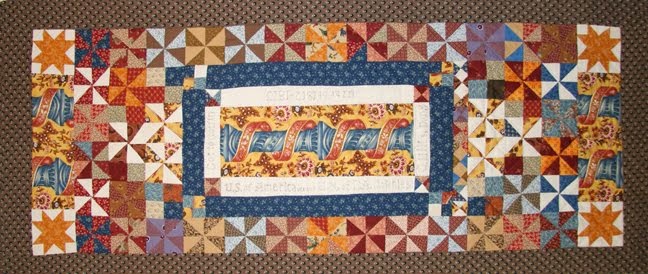
DeAnne from Lawrence, Kansas has titled her quilt: To Those Who Fought. She writes to tell us of her inspiration: "When visiting museums I have always been moved when I saw a piece that had a dedication on it. I decided to make a dedication quilt to those who fought in the War of 1812. In the dedication I included the names and ranks of my two 3rd great grandfathers and my two 3rd great uncles who fought in the War of 1812. Around my dedication I put Broderie Perse. Above and below the Broderie Perse I put applique. I surrounded the quilt with a patchwork border. Since this was a quilt intended for men I chose a patchwork that was masculine. I created the Broderie Perse using Barbara Brackman’s Lately Arrived from London Seaflower Muslin. I chose an applique design that I had seen on several quilts in the Victoria & Albert Museum from that time period. All of the fabric that I used for the applique and the border was from Barbara Brackman’s Lately Arrived from London line for Moda fabrics." 
Betty Anne of Markham Ontario is completing this quilt titled 1812 Rememberance and she tells us of her inspiration: "This started out as a historical challenge for the members of the Markham Towne Quilters Guild. Mary Mullen was in charge of presenting us with blocks that would represent the 1812 period in time. We were also challenged to find fabric that would have been available during this time period. The fact that black was not a possible dye colour ruled out a lot of the civil war fabrics available. I travelled from quilt store to quilt store to find fabrics that meet the requirement of 2-3 colour dots on the fabric selvedge, but that was very limiting but also very interesting to research colours that were prevalent during 1812.I found a cream & brown toile fabric that would let me try my hand at some Broderie Perse of 2 birds (male & female), also flowers, leaves and a butterfly for the centre. Pinwheels of browns, reds and blues surround the centre. I used a few of the blocks presented by Mary Mullen of MTQG and put my own spin on the design by using pinwheels, stars and connecting blocks. I've also used a fabric that I would call a cheddar colour which would have been popular during this time. I decided to frame the quilt in red around the border and binding."
Let us know how your quilt is coming along and please send some photos even if it is still under construction! We would love to see what you've been doing.











